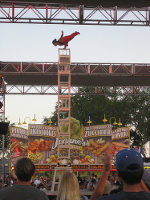I saw 3D Theatricals’ production of Beauty and the Beast this weekend and really enjoyed it. It was much better than the stripped-down touring version we saw in 2010. Bigger cast, bigger orchestra, more elaborate costumes and sets, and they didn’t cut any of the songs (including the one I kind of wish they had).
Great performances from the leads. Belle was a little more brassy than I’m used to, but it worked. The scenes with her and Maurice at the beginning had a nice geeky-family-hanging-out feel to them. Gaston’s performance actually reminded me a lot of Captain Hammer.
It was interesting to see how they worked around the lack of an understudy for Lumiere. They said he (and the actor playing Chip) had been delayed by a car accident, which may have been one he was involved in, or may have been the multi-car fatal collision and fire that shut down the 5 freeway for the whole day. They pulled an actor from the ensemble who had never rehearsed the part, and while he knew a lot of it, they still had to work around things like the dance steps in “Be Our Guest.” (Belle stepped in and offered to lead.) The regular actor made it there before act two and stepped back into the role.
Incidentally: Chip is a thankless part. You have to sit inside a cart wearing a giant teacup on your head the entire time you’re on stage. Though I’m impressed at what it takes to play Mrs. Potts: You need to hold one arm up the entire time (or else wear a very unbalanced costume on your shoulder, which I can imagine messing up your back), and push that cart around one-handed, with choreography. I hope directors/costumers are willing to adapt the costume for the actress’ dominant hand.
Anyway, it was a good production, and an interesting live-theater snafu. Sadly, I was the only one flu-less enough to go, and it was the last weekend of a short run. One of these days!





